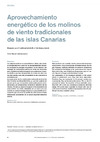Identificador persistente para citar o vincular este elemento:
https://accedacris.ulpgc.es/jspui/handle/10553/114559
| Campo DC | Valor | idioma |
|---|---|---|
| dc.contributor.author | Cabrera García, Víctor Manuel | en_US |
| dc.date.accessioned | 2022-05-03T12:18:17Z | - |
| dc.date.available | 2022-05-03T12:18:17Z | - |
| dc.date.issued | 2017 | en_US |
| dc.identifier.issn | 0040-1838 | en_US |
| dc.identifier.uri | https://accedacris.ulpgc.es/handle/10553/114559 | - |
| dc.description.abstract | Las máquinas eólicas en la actualidad se utilizan para producir energía eléctrica a partir de los aerogeneradores buscando incorporar las energías renovables a la red eléctrica. Sin embargo, los tradicionales molinos de viento son elementos de la arquitectura tradicional popular que pertenecen al pasado debido a que han desaparecido los modos de vida a los que iban ligados y, por ello, actualmente no son útiles para la sociedad actual. La conservación de los tradicionales molinos de viento en las islas Canarias resulta problemática ya que han quedado en desuso, por lo que se muestran inadecuados para la sociedad actual y, en consecuencia, se facilita el abandono de los mismos. Por ello se propone recuperar el funcionamiento de estos molinos de viento, dotándolos de un nuevo uso que consiste en producir energía eléctrica, lo que posibilitaría recuperar lo que aún no se ha perdido de estas construcciones tradicionales procedentes de la cultura industrial tradicional canaria | en_US |
| dc.description.abstract | Wind machines are currently used to produce electricity from wind turbines, trying to incorporate renewable energy into the grid. However, traditional windmills are elements of traditional folk architecture that belong to the past because the ways of life to which they were linked have disappeared and, as a result, they are no longer useful for today’s society. The conservation of the traditional windmills in the Canary Islands is problematic since they have been deprecated. Therefore, they are inadequate for the present society and, consequently, they can be easily abandoned. This is why it is proposed to restore the operation of these windmills, providing them with a new use consisting of producing electrical energy. This would make it possible to recover what has not yet been lost from these traditional constructions from the traditional Canarian industrial culture. | en_US |
| dc.language | spa | en_US |
| dc.relation.ispartof | Tecnica Industrial | en_US |
| dc.source | Tecnica Industrial [ISSN 0040-1838], n. 317, p. 58-66, (Agosto 2017) | en_US |
| dc.subject | 6201 Arquitectura | en_US |
| dc.subject.other | Molinos de viento | en_US |
| dc.subject.other | Patrimonio | en_US |
| dc.subject.other | Restauración | en_US |
| dc.subject.other | Rehabilitación | en_US |
| dc.subject.other | Conservación | en_US |
| dc.subject.other | Windmills | en_US |
| dc.subject.other | Heritage | en_US |
| dc.subject.other | Restoration | en_US |
| dc.subject.other | Rehabilitation | en_US |
| dc.subject.other | Conservation | en_US |
| dc.title | Aprovechamiento energético de los molinos de viento tradicionales de las islas Canarias | en_US |
| dc.type | info:eu-repo/semantics/article | en_US |
| dc.type | Article | en_US |
| dc.description.lastpage | 66 | en_US |
| dc.description.firstpage | 58 | en_US |
| dc.investigacion | Ingeniería y Arquitectura | en_US |
| dc.type2 | Artículo | en_US |
| dc.description.numberofpages | 9 | en_US |
| dc.utils.revision | Sí | en_US |
| dc.date.coverdate | Agosto 2017 | en_US |
| dc.identifier.ulpgc | No | en_US |
| dc.contributor.buulpgc | BU-ARQ | en_US |
| item.fulltext | Con texto completo | - |
| item.grantfulltext | open | - |
| crisitem.author.dept | GIR TIDES: URSCAPES | - |
| crisitem.author.dept | IU de Turismo y Desarrollo Económico Sostenible | - |
| crisitem.author.dept | Departamento de Construcción Arquitectónica | - |
| crisitem.author.orcid | 0000-0002-8203-3169 | - |
| crisitem.author.parentorg | IU de Turismo y Desarrollo Económico Sostenible | - |
| crisitem.author.fullName | Cabrera García, Víctor Manuel | - |
| Colección: | Artículos | |
Visitas
220
actualizado el 12-jul-2025
Descargas
122
actualizado el 12-jul-2025
Google ScholarTM
Verifica
Comparte
Exporta metadatos
Los elementos en ULPGC accedaCRIS están protegidos por derechos de autor con todos los derechos reservados, a menos que se indique lo contrario.
